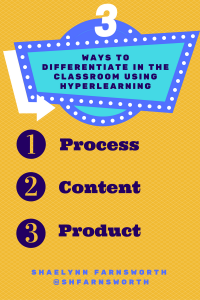This is a post from Guest Instructor Shaelynn Farnsworth.
HyperDocs or “HyperLearning” as I prefer to call it, involves a well-crafted digital lesson for student use which engages them in inquiry-based learning and can differentiate learning in the classroom. It typically involves the hyperlinking of material, resources, tasks, and information students can access from a single document or access point. HyperLearning is most commonly associated with Google Suite for Education because of the cloud-based and collaborative options provided by Google Docs, Google Slides, Google Forms, etc. but anything with a link can be used in HyperLearning.
In classrooms around the world there are two givens, there will be content requirements in the form of standards and students will vary as learners. With various roadmaps for each learner, differentiation in the classroom is necessary to meet student needs. Technology and differentiation are fundamentally changing instruction and HyperLearning is a prime example of this phenomenon.
HyperLearning, when aligned to Carol Ann Tomlinson’s research and findings, can directly impact student learning through differentiation in Process, Content, and Product.
Process
- What: Process involves how students take in and make sense of content. Whether the student prefers visual, aural, verbal, or kinesthetic learning; or perhaps social learning or learning in solitaire. The ability of educators to replicate themselves to support all learners is greatly heightened with the use of Hyperlearning.
- How: Through HyperLearning, teachers can provide multiple modes in which content can be disseminated and accessed by students. Providing multiple avenues in which students acquire content not only meets student needs but also provides a metacognitive glimpse where students can begin to understand their personal learning preference.
- Example: In a writing classroom where students are identifying characteristics of dynamic leads and then applying the learning in their own writing HyperLearning would provide students with multiple modes in which to access and make sense of leads. This could be in the form of a hyperlinked video, an infographic, written examples, an interactive graphic organizer, or a live demonstration from an author.
Content
- What: Content refers to the information, ideas, or concepts students grapple with to meet learning objectives. Differentiating content can be based on student interests, preferences, or readiness. HyperLearning allows for content differentiation to be met with ease.
- How: Curating differentiated content has become commonplace with the amount of information available on the web. Collecting, sharing and accessing differentiated content via HyperLearning increase student engagement, relevance, and meets the needs of students.
- Example: Students are learning reading strategies to identify claims and evidence in nonfiction text. HyperLearning can not only support the process in which students understand this strategy but can also be used to differentiate and provide differentiated content to students in which to apply their learning. For example, students may choose an article based on lexile level or subject matter that appeals to them. HyperLearning provides a common entry point for students in which choice can be provided based on need or preference. For example, using different layers on a Google Map provides differentiation all in one place.
Product
- What: Product is how students show what they know, understand, and can do. Demonstration of understanding in a differentiated classroom provides student choice and amplifies student voice. While having students work on different projects or products seems like a daunting task for educators, HyperLearning supports the process, collaboration, and sharing of these student-produced products.
- How: Through the use of virtual spaces, collaborative resources and creation apps students have the ability to collaborate, create, and share different products unique to them. HyperLearning makes the thinking and process visible while supporting differentiation. It also allows the audience to shift from the classroom to the world. Depending on objective and purpose, HyperLearning provides an avenue for student products to be collectively shared with a larger audience.
- Example: During the study of Romeo and Juliet students are to argue who is to blame for the death of the young lovers along with providing justification for their stance. A five paragraph essay would be a traditional product students in the past would write and share. HyperLearning products that students may create in a differentiated classroom could include a blog post, a vlog, social media interaction, images, flowcharts, etc. HyperLearning not only supports differentiated products but provides space for students to share, provide feedback, collaborate and create all while meeting learning targets and demonstrating their conceptual understanding in a way that best suits them.
When educators dig deeply into HyperLearning the true benefits and paradigm shift in instruction occurs. There is no better way to differentiate in the classroom to meet all student needs then to use technology to support student learning, differentiate content, and provide demonstration of understanding through the creation of student chosen products!



